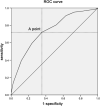Risk factors for blood transfusion in adolescent patients with scoliosis undergoing scoliosis surgery: a study of 722 cases in a single center
- PMID: 33402158
- PMCID: PMC7784304
- DOI: 10.1186/s12891-020-03869-z
Risk factors for blood transfusion in adolescent patients with scoliosis undergoing scoliosis surgery: a study of 722 cases in a single center
Abstract
Background: To assess the risk factors for blood transfusion in a great number of adolescent cases with different types of scoliosis who received scoliosis surgery.
Methods: Data of patients who were diagnosed as scoliosis and received one-stage posterior correction and spinal fusion from January 2014 to December 2017 were prospectively collected and retrospectively analyzed. Patients' demographic characteristics, segments of spinal fusion, Cobb angle of the major curve,osteotomy pattern, preoperative and postoperative levels of hemoglobin, and allogeneic blood transfusion (ABT) were recorded and analyzed.
Results: In this study, 722 cases with adolescent scoliosis were included, of whom 32.8% (237/722) received ABT. Risk factors included diagnosis: neurofibromatosis (OR = 5.592), syndromic (OR = 3.029),osteotomy: Ponte osteotomy (OR = 5.997), hemivertebrae resection (OR = 29.171), pedicle subtraction osteotomy (PSO)(OR = 8.712), vertebral column resection (VCR)(OR = 32.265);fusion segments (OR = 1.224) and intraoperative blood loss (OR = 1.004). In the subgroup analysis of cases with idiopathic scoliosis, Ponte osteotomy (OR = 6.086), length of segments of spinal fusion (OR = 1.293), and intraoperative blood loss (OR = 1.001) were found as risk factors for ABT. Results of receiver operating characteristic (ROC) curve analysis revealed that length of segments of spinal fusion equal to 11.5 vertebrae was the best cutoff value for cases with idiopathic scoliosis who did not receive osteotomy in both ABT group and non-ABT group. In the subgroup analysis of congenital scoliosis, Ponte osteotomy (OR = 5.087), hemivertebra resection (OR = 5.457), PSO (OR = 4.055), VCR (OR = 6.940), and intraoperative blood loss (OR = 1.004) were risk factors for ABT.
Conclusions: Method of diagnosis, osteotomy pattern, segments of spinal fusion, and intraoperative blood loss were risk factors for ABT in cases with adolescent scoliosis. In cases with idiopathic scoliosis, Ponte osteotomy and segments of spinal fusion longer than 11.5 vertebrae were risk factors for ABT. In cases with congenital scoliosis, osteotomy pattern was the main risk factor for ABT.
Level of evidence: Level III.
Keywords: Blood transfusion; Osteotomy; Scoliosis; Spine fusion.
Conflict of interest statement
NA
Figures



References
MeSH terms
LinkOut - more resources
Full Text Sources
Other Literature Sources
Medical
Research Materials

